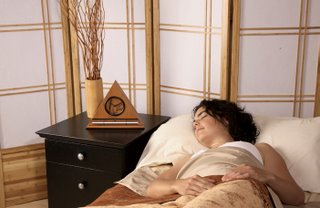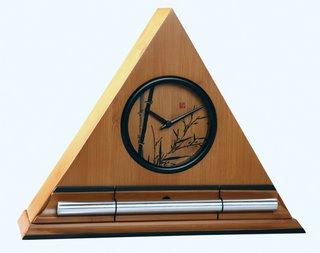
Turn your home into a sanctuary
By Sherri Silverman
In dreams, homes are often symbols of our physical bodies. In Vastu, the “yoga of design,” the structure of our homes is representative of our own bodies: what goes on in one affects the other, and our own little universes of body and home embody the same forces that compose the vast universe. In fact, Mayan (according to legend, the originator of Vastu knowledge some 10,000 to 14,000 years ago) is said to have coined the aphorisms “As in macro, so in micro,” and “As above, so below.”
Vastu is a scientific and spiritually based system of design for all kinds of buildings: temples, businesses, homes. It creates dwellings in which prana (subtle, universal life-force energy: what Chinese systems of feng shui and Oriental medicine call ch’i) flows freely and there are no structural elements that predispose us to illness or problems in life. Buildings constructed according to true Vastu are conducive to good health. The principles of Vastu can also be applied to rectify energy imbalances in existing homes and create the peace and stability we need to have success on all levels, spiritual and material.
Knowledge of Vastu traveled from India along the Silk Road and on sea routes with merchants and monks. It influenced native East and Southeast Asian traditions, as did other fields of knowledge from India: Hinduism, Buddhism, Jyotish (Vedic astrology), and Ayurveda. There are even legends that Buddha himself traveled to East and Southeast Asia and could have brought India’s great knowledge systems with him. Emperor Ashoka, a famous convert to Buddhism, sent specialists in India’s traditions to Southeast and East Asia to meet local practitioners, find their indigenous traditions, and offer knowledge. These probably brief seminars brought valuable information that melded with the local customs.
Like meditation and yoga, Vastu is universal and useful for people everywhere. It is not a style of architecture or interior design; it is a complete system based on natural laws that can work with your own sense of style and beauty. You can have a Tudor Vastu home or a New Mexico Territorial Vastu home, Spanish Mission–style Vastu architecture, or log cabin Vastu architecture. Likewise, you are not restricted to a particular style of interior design: lots of frills and lace or a stark, Zen-inspired interior can both work within the Vastu framework. Almost all of your individual preferences in color, style, materials, texture, and furnishings can work in a Vastu home or office. As long as it follows the guidelines, is beautiful, and is well constructed with natural materials, any architectural style or design scheme can work with Vastu.
Meditation connects us with the source of pure consciousness; Vastu enhances this effect and connects us with the source through proper design. As a result, it is particularly relevant to people who practice meditation and yoga. Anyone, however, can benefit from applying some Vastu to their home. Here are a few guidelines that will help you turn your home into a yogic sanctuary.
The Five Elements: Panchabhutas
The principles of Vastu connect the dweller of the Vastu home with the subtle laws of nature, such as the energy grid of the earth, beneficial earth energies, and cosmic energies from the sun. They also align the home with the five elements of earth, water, fire, air, and space, which are called panchabhutas in the Vedic tradition. Each of these five basic elements is energetically associated with a particular direction. This is not an arbitrary assignment but an acknowledgement of the subtle laws of nature. By honoring the various elements and their primal energies, we are in greater harmony with nature. This results in greater harmony and ease in our lives.
Earth: bhumi or prithivi
The earth element is associated with the southwest direction, the best choice for the location for the master bedroom. Earth is a solid, dense, and grounded element. We all need a physical basis or foundation to survive in this world. Plants, trees, soil, rocks, and mountains represent the earth element.
Water: jala
Northeast is the direction where the energy waves of the water element collect. This makes it the best placement for indoor and outdoor water features: swimming pools, fountains, ponds, waterfalls, and aquariums. Water is frequently used as a metaphor for pure consciousness in the Vedic tradition.
Fire: agni
The fire element is predominant in the southeast, so it is the best placement for kitchens, fireplaces, computers, and other electrical equipment. Digestion in the body and transformation are also the realm of agni. To add and honor this element, light fires. Enjoy an indoor or outdoor fireplace in the southeast, and light non-toxic candles made of beeswax.
Air: vayu
The air element is liveliest in the northwest, so put fans, wind streamers, mobiles, wind chimes, and air purifiers here. The concept of movement in general is associated with this element and its direction. To reap the benefits of the prana in the air, learn and practice pranayama (yogic breathing techniques), preferably with windows open enough to bring fresh air into the room. Be sure that the air in your home is fresh. If your home has stagnant areas, you can use fans to keep the air moving.
Space: akasha
This element is directly linked to sound and silence. Akasha (sometimes called “ether”) is the expansiveness in the center of the architectural form and in the center of each room, the element of “energetic and dynamic space.” The center of the building and each room is called the Brahmasthan. It is the interface between the seen and the unseen, the manifest and the unmanifest. Honor the Brahmasthanby keeping it clean and clear, a revered open space. Don’t put heavy objects here.
Vastu expert Sherri Silverman, PhD, is the founder of Transcendence Design. This article is adapted fromVastu: Transcenden-tal Home Design in Harmony with Nature by Sherri Silverman. © 2007 by Sherri Silverman. Reprinted with permission of Gibbs Smith.
One of the ultimate Zen like experiences is waking-up from a great slumber refreshed and energized. Your mind and body are harmoniously one, both alert and focused. Having a refreshed mind and body are two keys to a natural and Zen lifestyle. Waking up in the morning should not be a loud and abrupt awakening, but rather it should be a peaceful positive experience. The right natural alarm clock can transition your deep and tranquil sleep into a serene start to consciousness. Imagine a long-resonating Tibetan bell-like chime waking you up to a beautiful morning experience.
The right alarm clock can be the most beneficial investment for you. With our Now & Zen natural alarm clock you are awakened more gradually and thus more naturally. Now & Zen is focused on creating a naturalistic lifestyle, and our clocks are an example of our philosophy.

Bamboo Chime Clocks by Now & Zen
Now & Zen – The Gradual Chime Clock Store
1638 Pearl St.
Boulder, CO 80302
(800) 779-6383
Posted in Chime Alarm Clocks, nature